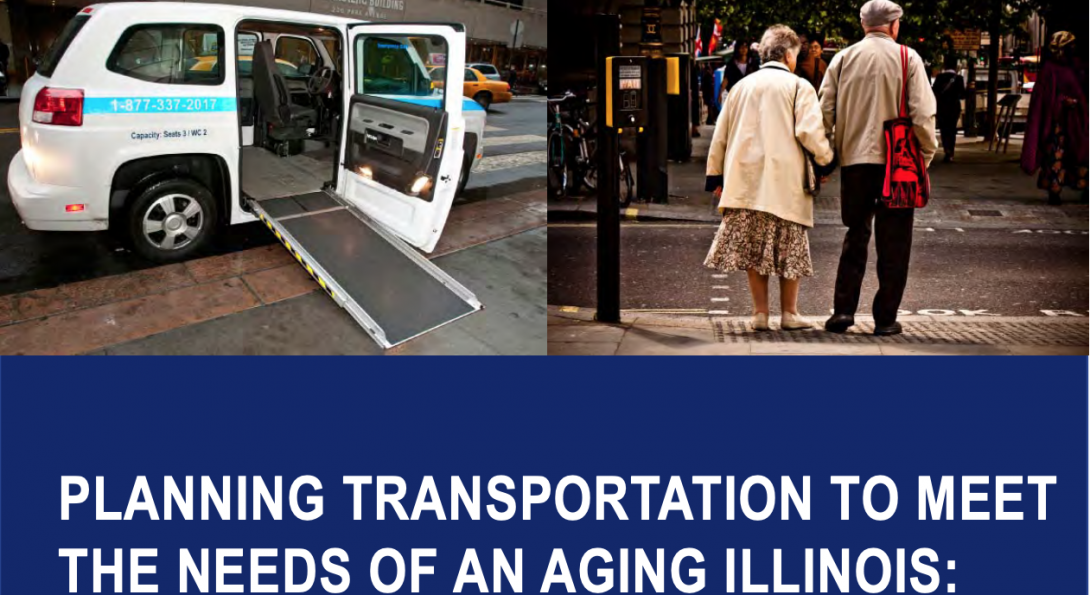Planning Transportation to Meet the Needs of an Aging Illinois: An Assessment

Research from Voorhees and Urban Transportation Centers at UIC Recommends Integrated Approach at Federal, State and Regional Levels
Communities throughout Illinois will need to make significant revisions to current transportation options, explore more varied housing types and greatly augment health and human services alternatives to meet the day-to-day needs of the increasing Baby Boomer population, which is estimated to grow to one-in-five residents by 2030.
Greater cooperation between state and federal agencies and a concerted commitment by elected officials charged with managing human services is paramount to ensuring the welfare of adults 60 years of age and older across Illinois in the years to come.
Those are among key findings and policy recommendations detailed in “Planning Transportation to Meet the Needs of an Aging Illinois: An Assessment,” a research report completed by the Nathalie P. Voorhees Center for Neighborhood and Community Improvement with participation from the Urban Transportation Center. Both research units are under the College of Urban Planning and Public Affairs at the University of Illinois at Chicago.
Three main conclusions were reached by the project team:
- Housing types geared to aging adults. Municipalities statewide should consider changes to zoning laws to allow for development of multifamily housing and residential construction on more compact lot sizes. This would better accommodate older adults planning to downsize and move to smaller homes.
- Enhanced home and community accessibility. Older adults will be able to stay in their homes longer and have greater access to services if homes can be modified for those with disabilities or limited mobility. New construction should include homes that offer greater accessibility.
- Addressing older adults in rural communities. The research showed that rural communities across Illinois have a greater concentration of older adults in proportion to the overall population. Older adults in these communities also may be more isolated than those in populated areas and may face greater challenges getting medical care and other services. Officials need to plan now to meet future transportation, healthcare and social service needs in rural parts of the state.
The project team concluded that heightened coordination of Human Services Transportation Planning (HSTP) initiatives within Illinois and on the federal level would be required to meet the demands of the state’s aging population. Specific recommendations include:
- Greater commitment and leadership on coordinated HSTP in Illinois at the state, regional and local levels.
- Create more efficient shared services and multi-modal regional HSTP options when possible.
- Develop workable “1-click/1-call” services statewide to coordinate HTSP services.
- Encourage true bi-partisan support at the federal level to guarantee funding.
- Eliminate federal barriers to transportation coordination.
- Consider replicating or expanding on existing federal programs, such as the Community Development Block Grant (CDBG) or Transportation Investments Generating Economic Recovery (TIGER) grants.
The report, which was finalized in July of 2014, addressed population projections, demographic characteristics of the state’s older adult population and current HSTP practices.
Researchers maintain that between 2010 to 2030, Illinois will experience a 76.3% gain or 648,129 residents in the 65 to 74 years of age population, a gain of 79.8% or 418,798 people aged 75 to 84, and a 65.1% increase or 152,866 residents over 85 years of age. Counties that had above-average concentrations of older adults were more rural in character and located in four parts of Illinois, all well outside metropolitan Chicago, which had the lowest proportion of older adults. HTSP coordinators surveyed were unanimous that the process has been beneficial, especially in rural areas, and all concurred that there was room for improvement.